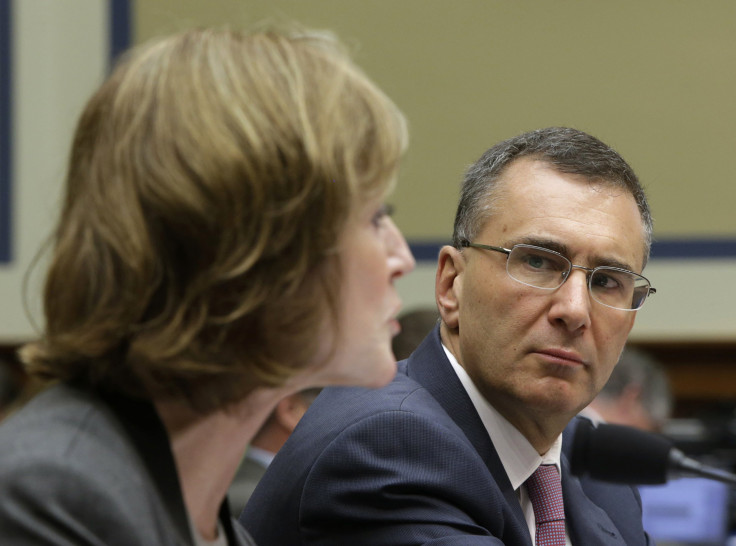Here’s Why Your Premiums Are Rising: Consumers Pay Insurers’ Annual Obamacare Fees

Back when lawmakers were crafting the health reform law that Congress is now working to dismantle, they sought to make a deal with large health insurers. In return for the influx of new policyholders who wouldn’t have otherwise been able or required to buy insurance, the industry behemoths would together fork over an annual, multi-billion-dollar fee, the amount of which would increase year by year. While the industry’s leading lobbyist has remained committed to its campaign to abolish the fee since then — characterizing it as a direct tax on consumers, as the group says insurers must cut benefits and raise premiums to pay for it — the collective profits of the five largest insurers have continued to rise.
Here’s where it gets confusing. In their third-quarter earnings, many health insurers, such as UnitedHealth Group Inc. and Anthem Inc., are reporting revenues stunted by a temporary suspension of the large annual fee imposed by the Affordable Care Act. That math may sound disjointed to the average reader, but it’s ubiquitous throughout the earnings reports of the biggest publicly-traded health insurance companies this year. And, with $14.3 billion for the industry to cough up when it’s set to return next year, the fee, and insurers’ response to it, is one reason Americans will likely face higher premiums and less-generous benefits in 2018.
Combined with UnitedHealth’s withdrawals from the ACA’s individual market, the suspension of the fee — alternately called the Health Insurer Fee (HIF), the Health Insurance Provider (HIP) Fee and the Health Insurer Tax (HIT) — “reduced consolidated revenues by approximately $1.6 billion,” the company said in its recent third-quarter earnings release. Aetna, which is expected to report third-quarter earnings Tuesday, noted a $430 million decline in year-over-year revenue in the second quarter, “primarily due to lower premiums… and the temporary suspension of the HIF in 2017.” Molina Healthcare, set to report its third-quarter results Thursday, similarly flagged a “reduction to revenue as a result of the 2017 Health Insurer Fee (HIF) moratorium” in its second quarter Securities and Exchange Commission filing.
Anthem, in its third-quarter filing Wednesday, was transparent in how it addresses the yearly fee, which Congress suspended for 2017 when it passed 2016 appropriations legislation. The company noted that, while operating revenue had increased, it was “offset by the impact of lower Health Care Reform fees, primarily due to the HIP Fee suspension for 2017, as we did not price affected products to cover any HIP Fee related expense in the current year.” Similarly, Cigna, expected to report earnings Thursday, said in its previous quarterly SEC filing that “our pricing actions in 2017 reflected the moratorium on the industry tax, whereas in 2016 we included this tax in our premium rates.”
In other words, the insurers say that the loss of a massive government-imposed fee has hurt their revenues — because with the fee in place, they raised premiums and cut benefits.
The ACA and the Health Care Education and Reconciliation Act together imposed the non-tax-deductible annual fee on insurers as a way for the government to both recoup the advantages of the ACA to those companies and keep the health care law fiscally sound, former officials from the previous administration told International Business Times. Those involved in and familiar with the law’s development said they’d hoped the firms would take at least a something of a hit to their profit margins to cover it, in return for the influx of new policyholders thanks to Obamacare’s individual mandate and subsidies that helped lower-income Americans afford the cost of health care. (In mid-October, President Donald Trump announced plans to eliminate the latter.)
Analysts, on quarterly earnings calls, suggested profits as one of several places where insurers could cushion the fee’s financial blow. An analyst from JPMorgan Securities LLC on Humana’s second-quarter earnings call, for example, suggested, “either you have to absorb the differential in terms of lower earnings growth, you have to reduce benefits, you have to cut [general and administrative costs] or you have to raise premium” when the fee returns in 2018. The company’s chief financial officer, Brian Kane, responded that it was not possible to take the windfall from the absence of the fee this year “and invest it in benefits.” Anthem CFO John Gallina said on his company’s recent third-quarter earnings call that “the HIP fee always impacts every analysis,” and, consequently, between 2017 and the other years in which Anthem paid the fee, “profitability by line of business, all the ratios, all the metrics, are all really non-comparable.”
Although Brian Thompson, who heads UnitedHealth’s Medicare and Retirement division, promised in the company’s second-quarter earnings call to “keep our benefit offerings as stable as possible” with the return of the fee in 2018, the company’s then-CEO had a different take. The fee “really affects the cost for consumers,” Stephen Hemsley said. In the third-quarter earnings call, Hemsley’s replacement, David Wichmann, reiterated this view, saying the fee “ultimately increases [the] cost to consumers through either increased premiums or benefit reductions.” Cigna CEO David Michael Cordani, when asked about the return of the fee on his company’s second-quarter earnings call, more or less hinted at the relative inelasticity of demand for health insurance policies when said, “we do not see a demonstrable change in purchasing patterns” as a result of price changes in response to HIF.
Adjusting prices to corporate or sales taxation is a normal business practice, so the insurers’ descriptions of revenue increases in response to the fee and the lobbying group’s warnings of higher costs are not unusual or absurd. Worse for insurers, the non-deductible nature of the fee has tended to expand insurers’ tax rates by upwards of 10 percent, according to their annual and quarterly reports. Yet between 2010 and 2016, an IBT review of SEC filings shows, the total net income of the five biggest publicly-traded American health insurers — namely, UnitedHealth, Anthem, Aetna, Cigna and Humana — has grown by nearly $2.5 billion, to 14.2 billion in 2016 .
“Money being fungible, it’s hard for policymakers to require a fee to come out of profits and not be passed on to consumers, at least where one is not dealing with a regulated public utility,” J. Mark Iwry, who served as senior adviser to the Treasury Secretary and the department’s deputy assistant secretary for Retirement and Health Policy within the Obama administration, told IBT. “How much they can pass on to consumers is ultimately a matter of economics and a function of the operations of the market.”
‘This Is Going To Make You A Lot Of Money, So We’d Like You To Kick Some Of That Back’
As officials ironed out the ACA in 2009, they planned on hitting three industries — drug makers, health insurers and medical device manufacturers — with yearly fees to help support Obamacare financially in return for the business boost the sectors would get with Americans’ greater access to coverage. The portion a company would pay depended on its market share, a detail intended to keep small companies from going bankrupt as larger ones comfortably took the blow.
The health insurance industry’s initial required payment, for the 2014 calendar year, was $8 billion. The total has since swelled to $11.3 billion in both 2015 and 2016, and, without the suspension, would have grown to $13.9 billion this year. For pharmaceutical companies, the total started at $2.5 billion in 2011 and has gradually increased to $4 billion since then.

Medical device makers originally would’ve paid $4 billion at the outset, but, according to a 2014 study of that part of the health care legislation by the Indiana Law Journal, the fee dropped to $2 billion, then “ evolved into an excise tax after much lobbying by the largest medical device manufacturers who claimed it was unfair.”
“Upon rejection of the annual fee,” the study noted, “Congress originally set the excise tax rate at 2.9 percent, but again under lobbyist pressure, Congress reduced it to the 2.3 percent.” The medical device makers would thus be charged with providing Obamacare with $29 billion in support over the decade spanning 2013 to 2022 — about $5 billion less than the pharmaceutical companies would collectively pay, and less than a third owed by the health insurance industry, over the same period.
Regardless of what device manufacturers paid, the disparity between what insurers and drug makers contributed was substantial, as Rick Newman of U.S. News and World Report pointed out at the time, with the pharmaceutical industry contributing far less than their share of the three sectors’ collective revenues. The pharmaceutical industry also enjoys profit margins of, for some firms, upwards of 30 or 40 percent; for medical device makers, that number is closer to 10 or 15 percent, and for insurers, it’s generally in the single digits.
Kristine Grow, the senior vice president for communications at America’s Health Insurance Plans Inc., the leading industry lobbyist, told IBT that while she did not wish to comment on the ACA fees shouldered by other sectors, she “will point out that pharmaceutical companies have much higher profit margins.”
But drug makers also didn’t receive nearly as much windfall as insurers in the wake of the ACA’s enactment, according to Jonathan Gruber, a Massachusetts Institute of Technology professor and former health care policy technical consultant for both President Barack Obama and former Massachusetts Gov. Mitt Romney.

“On one hand, they are more profitable. On the other hand, they’ve seen the least gains from this law,” Gruber, known for his staunch defense of Obamacare, said of pharmaceutical firms. Referring to the health insurance sector, he added, “It’s like, this is going to make you a lot of money, so we’d like you to kick some of that back.”
‘The Money Has To Come From Somewhere’
To kick back those billions, health insurance firms have adjusted their offerings to policyholders, as a 2013 report by the consultancy Milliman Inc. predicted, and are largely expected to do so again when the fee returns in 2018. A more recent analysis conducted by the management consulting firm Oliver Wyman, and, it’s worth noting, commissioned by UnitedHealth Group, predicted that the fee will result in a nearly 3 percent rise in premiums each year after 2018, with individuals facing yearly increases of between $165 and $500, depending on their coverage. Others, like Congress’ Joint Committee on Taxation, have estimated annual premium increases of between 2 and 2.5 percent.
The ACA includes a provision to keep insurers from jacking up the annual premiums they charge. Known as the Medical Loss Ratio, it mandates that companies spend 80 percent of premium incomes on improving quality and providing better care for policyholders — something Grow, of AHIP, was quick to point out. Only a fifth can be used for marketing, administrative costs and profits. For insurers selling group policies to companies with 50 employees or more, that ratio changes, with at least 85 percent set aside for care and quality and 15 percent allowed for profits and expenses that directly benefit the insurance company.
AHIP, the insurance industry lobbyist, has said the provision is “penalizing” insurers by misunderstanding the relationship between a company’s Medical Loss Ratio and the value of its plans to its customers. AHIP has also led the campaign against the annual health insurer fee.
The organization paid lobbyists close to $1.5 million during the third quarter to lobby Congress, the White House and various executive agencies on “issues relating to the annual fee on health insurance providers” and “issues related to medical loss ratios,” among other policy areas, according to federal lobbying forms. It’s been lobbying on MLR since 2009 and the annual fee since at least 2011, spending upwards of $2 million in some three-month periods, federal lobbying records show.
In a July letter to Senate Finance Committee Chair Orrin Hatch (R-UT), AHIP’s president and CEO, Marilyn Tavenner, who served as Centers for Medicare and Medicaid administrator from 2011 to 2015, thanked him for “helping to approve a one-year suspension of this tax for 2017” and told him the fee “has raised the cost of health insurance premiums by more than $100 billion.”
“That is why repealing this costly tax is so important,” Tavenner wrote, citing drops in certain types of coverage between 2008 and 2015. “We urge you and the Congress to fully repeal this tax so that millions of hard-working Americans can see lower premiums.”
In an “issue brief” on AHIP’s website, the group describes the fee as “a tax that will exceed $156 billion over the next 10 years (2017-2026) on families, small businesses, seniors, states and taxpayers, in what is essentially a sales tax on health insurance coverage.”
“Right now, health plans are finalizing their products for 2018 ahead of state and federal filing deadlines. If repeal or suspension of the tax for 2018 is not included in a legislative package before those filing deadlines, these 2018 products will have to factor in the cost of the health insurance tax,” the issue brief continues. “It is important for Congress to take swift action to suspend the health insurance tax into 2018 and beyond to continue to improve the affordability of health insurance coverage for millions of consumers.”
When asked whether AHIP’s members — which include Anthem, Cigna, Humana, Molina, Kaiser Permanente and a dozen state companies of the Blue Cross Blue Shield Association — could absorb the costs of the fee elsewhere, Grow told IBT “that’s not how a tax works,” and that insurers must price it in like any company would a sales tax.
As Kent Smetters, a Wharton business economics and public policy professor, told IBT, the level of competition within the health insurance industry lent firms little space to take the hit themselves. With greater competition, he noted, existing price mark-ups tend to be smaller, which “implies more pass-through” of the fee expense to policyholders.
“There is not much the government can do to prevent pass-through unless they want providers to go bankrupt,” Smetters said. “Insurers will typically pass it on. Competition forces them to do so because they have low margins — currently negative for many of them.”
Still, he added, with a ballooning government deficit, “the money has to come from somewhere.”
Indeed, without the annual fee, government revenues would take a multi-billion-dollar hit. The Joint Committee on Taxation estimated that, if the annual fee on pharmaceutical manufacturers were struck down as part of a general repeal of the ACA, the loss of government revenue would total $24.8 billion in the decade spanning 2017 to 2026. If the annual fee on health insurers were repealed, according to the committee, government revenue would drop $144.7 billion over the same period.
‘A Lot Of Messaging’
Ezekiel Emanuel, a professor at the University of Pennsylvania’s Wharton School, bioethicist and former Obama administration health care adviser, didn’t pull any punches when describing the insurance industry reaction to the fee.
“Insurance companies have been expert at blaming lots of stuff... on the ACA that have nothing to do with the ACA,” said Emanuel, who reportedly advised the current administration on health care policy early this year.

Suggestions of raising premiums and cutting benefits in response to the fee were simply “a lot of messaging,” and curtailing the practice was a responsibility of state insurance commissioners rather than the federal government, he said.
In light of the House passage of the fiscal year 2018 budget, which includes a provision allowing the House Budget Committee chair to revise the appropriations “for the budgetary effects of any bill… that repeals and replaces any provision of the Patient Protection and Affordable Care Act,” and Congress’ repeated attempts to accomplish that feat, Emanuel was skeptical.
“If you open up renegotiations, you open up a can of worms,” said Emanuel, who has previously written that low profit margins already leave health insurers with relatively little room to help cover the exorbitant costs of health care in the U.S. “You know, ‘Cut me, cut me!’ You’re not going to get a situation of more fairness.”
Gruber, the former technical consultant to Obama and Romney who’s now at MIT, echoed Emanuel’s point on messaging, noting that the insurers “could always raise premiums,” and that “the tax is an excuse.” And as the current administration and Congress work to reengineer U.S. health care policy, he said, they’ll still have to keep the government balance sheet in mind.
“The ACA had a balancing act,” Gruber said. He added, in reference to the fee, “If you don’t do it, the deficit goes up.”
© Copyright IBTimes 2024. All rights reserved.






















